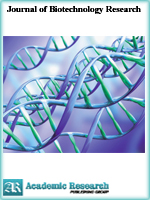Journal of Biotechnology Research
Online ISSN: 2413-3256
Print ISSN: 2413-8878
Print ISSN: 2413-8878
Quarterly Published (4 Issues Per Year)

Archives
Volume 4 Number 11 November 2018
Study of the Structural Properties and Morphologies of Gold Thin Films Deposition by Annealing
Authors: Feridoun Samavat ; Zahra Fereidouni ; Faezeh Ghaderi
Pages: 83-88
DOI: doi.org/10.32861/jbr.411.83.88
Abstract
In this paper, the effect of annealing temperature on properties of gold thin films has been investigated. Au thin films have been deposited on glass substrates by the electron beam coating technique and afterward subjected to annealing in a mixed ambient of air and oxygen at 575, 650, 725, 800 and 875 K for 1 h and then cold slowly. The crystallographic structure of Au thin films was studied as a function of the annealing temperature. X-ray diffraction was used to estimate the crystallographic texture, grain size. All the films were found to have crystalline structure. The films morphologies were studied by scanning electron microscopy (SEM). The surface topographies were studied using atomic force microscopy (AFM). (AFM) analysis showed the gold layer growth to be running over isolated islands. The XRD and SEM and AFM results confirmed the presence of gold particle in thin films.
Construction, Expression, and Purification of ZNF191 (243-368) Zinc Finger Deletion Mutants
Authors: Dongxin Zhao ; Zhongxian Huang
Pages: 80-82
DOI: doi.org/10.32861/jbr.411.80.82
Abstract
The C-terminal region of the zinc finger protein ZNF191(243-368) contains a putative DNA-binding domain containing four Cys2His2 zinc finger motifs. To understand the properties and functions of the zinc finger motifs, a deletion gene of ZNF191(243-368) was inserted into pGEX-4T-2. The recombinant vector was transformed into Escherichia coli BL21, and a glutathione S-transferase (GST) fusion protein was expressed and purified using glutathione agarose affinity resin. The results show that this expression system can be used to express and purify zinc finger deletion mutants of ZNF191(243-368), providing a basis for further investigation of this protein.



